JOHN COLTRANE / “Blue Train”
Sometimes we don’t know who we are until some one or some thing comes along and smacks us—Whap! Whap! (Twice as it were to make sure it got our attention.) Maybe it was the sight of something we’ve never seen. Maybe it was a tall, tall black woman coming down the aisle of some old-ass department store, tall and beautiful, walking—no, actually striding, her walk akin to an antelope’s lope: graceful, captivating. You were looking at her walking, marveling, admiring. Her eyes staring straight ahead at you but you could not stop looking. She was not challenging you but she was in some way challenging your sense of aesthetics, making you clear-cut the forest of bullshit-beauty, the debris of old ideas cluttering up your head, and she, as she draws near you, smiles. And shit, she is smiling at you, and now you notice the crown that had captivated you from afar—she is wearing her hair natural. No grease, creams or alterations other than water and the results of genetics curling her locks tightly into a soft, black, wooly mass. And now she is almost up in your face, and you are young, and it is the early, early sixties, and you never seen a six foot, black, beautiful, natural-wearing woman walking toward you and smiling like she is smiling when she says, “Hey, my brother.” And suddenly you know, you know you are kin to beauty and goodness and elegance and everything natural. She has told you with three words that it’s not just about her or just about you but about all of us who want to return the world to nature. And goddamn if you are not glued to one spot for a moment but freer than you’ve ever been and all of sudden you’re not only imagining things you have never thought of before but also imagining yourself as a brother to beauty. Hey my brother, this is love, this is a new day. This is what the world can look like if we change up from the old and straighten our heads by unprocessing our minds.
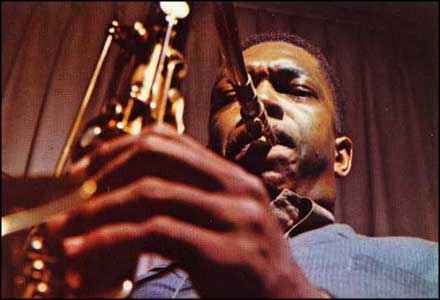 Coltrane was like that. Coltrane opened a lot of us up, and out. Made us think of us-selves in ways not previously thought about. And like genies and jars, once Coltrane’s sound rubbed us, nobody could completely bottle us back up. Once out there a minute, staying inside for the rest of our days was impossible. So we sought and continue to seek the exit. Or as Jimi (another visionary who was covering Dylan, who himself had pretty good vision too) said: there must be some kind of way out of here.
What took Trane out was the blues. Understanding the totality of the blues as black response to a world of whiteness, not simply colors but social construct(ion)s. Trane figured out how to go forward by going backwards. Trane = Sankofa. Moving into the future while facing the past. To face the past, to embrace the blues, Trane’s recipe for greatness.
“Blue Train” was the first stop after leaving the station. Prestige Records had had Trane working the fields for a relatively long time. Trane, grip in hand, was leaving the farm and even before he was officially gone, before his work contract was expired, he slipped off one night and made it over to Blue Note to do a one-off quickie. When it hit, heads went crazy. Man, what was this? The LP's title said it all: Blue Train. Another man done gone; way gone, way out there for more than a minute.
Coltrane was like that. Coltrane opened a lot of us up, and out. Made us think of us-selves in ways not previously thought about. And like genies and jars, once Coltrane’s sound rubbed us, nobody could completely bottle us back up. Once out there a minute, staying inside for the rest of our days was impossible. So we sought and continue to seek the exit. Or as Jimi (another visionary who was covering Dylan, who himself had pretty good vision too) said: there must be some kind of way out of here.
What took Trane out was the blues. Understanding the totality of the blues as black response to a world of whiteness, not simply colors but social construct(ion)s. Trane figured out how to go forward by going backwards. Trane = Sankofa. Moving into the future while facing the past. To face the past, to embrace the blues, Trane’s recipe for greatness.
“Blue Train” was the first stop after leaving the station. Prestige Records had had Trane working the fields for a relatively long time. Trane, grip in hand, was leaving the farm and even before he was officially gone, before his work contract was expired, he slipped off one night and made it over to Blue Note to do a one-off quickie. When it hit, heads went crazy. Man, what was this? The LP's title said it all: Blue Train. Another man done gone; way gone, way out there for more than a minute.
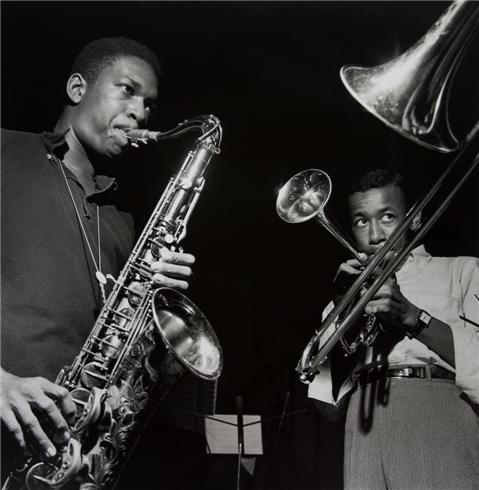 Check the passenger manifest: Lee Morgan (trumpet), Curtis Fuller (trombone), John Coltrane (tenor), Kenny Drew (piano), Paul Chambers (bass), Philly Joe Jones (drums)—Rudy Van Gelder Studio, Hackensack, New Jersey, September 15, 1957. Already Mr. Trane was going somewhere and taking people with him. This is recognized now (and even way back in the late fifties) as Trane’s first jazz classic.
It’s in the style of the territory bands. Horn riffs behind Trane’s solo. A churning bass walk like the flywheel on a locomotive. The drummer doing a modified shuffle beat on the cymbals but staccato accents on the snare in order to keep it from falling off into commercial territory.
Check the passenger manifest: Lee Morgan (trumpet), Curtis Fuller (trombone), John Coltrane (tenor), Kenny Drew (piano), Paul Chambers (bass), Philly Joe Jones (drums)—Rudy Van Gelder Studio, Hackensack, New Jersey, September 15, 1957. Already Mr. Trane was going somewhere and taking people with him. This is recognized now (and even way back in the late fifties) as Trane’s first jazz classic.
It’s in the style of the territory bands. Horn riffs behind Trane’s solo. A churning bass walk like the flywheel on a locomotive. The drummer doing a modified shuffle beat on the cymbals but staccato accents on the snare in order to keep it from falling off into commercial territory.
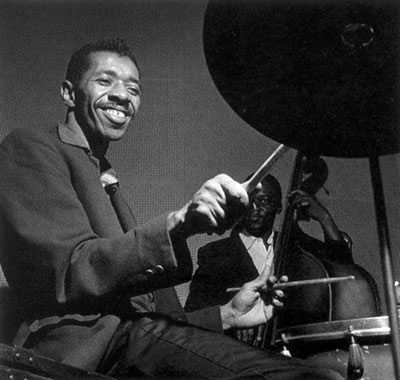 Philly Joe is insanely adept at keeping two times simultaneously, displaying that graceful walk the red caps (i.e., Pullman porters) could do carrying a loaded tray down the aisle of a swiftly moving train. Listen to what happens behind (Gillespie acolyte) Lee Morgan’s trumpet solo: with the left side of his body (snare and sock cymbal) Philly Joe accents the quick time while on the right side he keeps it steady on the walk.
There are very few trombone solos on Coltrane records and on the Blue Train LP Curtis Fuller has most of the existing examples. This is some of the best jazz of the mid-fifties, a time when jazz was in deep transition and shortly (in 1959) would bust all the way out with seminal statements from Ornette Coleman, Charlie Mingus, Miles Davis and, of course, John Coltrane. Actually, Blue Train is part of one of the most important periods in the formation of post-bop, modern jazz.
By 1960, Trane was moving like a cheetah, twisting and turning fast as a mofo with his ass on fire! He was completely off the farm and was now recording his own compositions unencumbered by Prestige’s attempts to own his publishing. Trane was about freedom; he had horded his work until he could make a break. Once he got free he left multiple calling cards all over the place for the world to dig.
Check Trane’s first commercial recording with McCoy Tyner. It’s a piece dedicated to Sonny Rollins: “Like Sonny,” AKA “Simple Like.” The musicians are John Coltrane (tenor sax), McCoy Tyner (piano), Steve Davis (bass) and Billy Higgins (drums) at the United Recording Studios, Los Angeles, CA on September 8, 1960. The album is called Like Sonny. Here we are getting a preview as Trane is beginning to put together the classic quartet. Consistent with all major developments in jazz (which is, after all, a communal art-form) John Coltrane knew he needed cohorts to fully develop his music. He was carefully recruiting.
I like the theme of “Like Sonny.” Its sing-song melody invites you to hum along.
By October of 1960, Trane had assembled three quarters of the classic quartet with McCoy Tyner on piano and Elvin Jones on drums. (Bassist Jimmy Garrison would join them shortly.) In 1960, Trane recorded enough music to make four or five albums (Like Sonny on Roulette Records; and John Coltrane/Don Cherry The Avant Garde, Coltrane Jazz, My Favorite Things, Coltrane Jazz, and Coltrane’s Sound, all on Atlantic Records). An amazing run of material.
“Mr. Syms” is from Coltrane Plays The Blues and is a loping blues that seems to float along effortlessly in the style of an Ethiopian marathon runner (or that black woman who so indelibly influenced teen-aged me!). You can easily hear the difference drummer Elvin Jones makes compared to the two previous examples. Jones was the master of swinging hard without swinging at all, by which I mean he eventually left the time-keeping function to the bass and instead pushed poly-rhythms. On “Mr. Syms” Jones is not fully in the new bag yet but you can feel the freedom coming in his left hand even as he is steady on it with the right.
This is also a further exploration of the soprano saxophone, which Coltrane single-handedly restored to the pantheon of quintessential jazz instruments. Before Trane the soprano had been forgotten; after Trane almost everybody doubled or dabbled on soprano even if their main horn was alto, which is in a different key (unlike the natural pairing of tenor and soprano).
Philly Joe is insanely adept at keeping two times simultaneously, displaying that graceful walk the red caps (i.e., Pullman porters) could do carrying a loaded tray down the aisle of a swiftly moving train. Listen to what happens behind (Gillespie acolyte) Lee Morgan’s trumpet solo: with the left side of his body (snare and sock cymbal) Philly Joe accents the quick time while on the right side he keeps it steady on the walk.
There are very few trombone solos on Coltrane records and on the Blue Train LP Curtis Fuller has most of the existing examples. This is some of the best jazz of the mid-fifties, a time when jazz was in deep transition and shortly (in 1959) would bust all the way out with seminal statements from Ornette Coleman, Charlie Mingus, Miles Davis and, of course, John Coltrane. Actually, Blue Train is part of one of the most important periods in the formation of post-bop, modern jazz.
By 1960, Trane was moving like a cheetah, twisting and turning fast as a mofo with his ass on fire! He was completely off the farm and was now recording his own compositions unencumbered by Prestige’s attempts to own his publishing. Trane was about freedom; he had horded his work until he could make a break. Once he got free he left multiple calling cards all over the place for the world to dig.
Check Trane’s first commercial recording with McCoy Tyner. It’s a piece dedicated to Sonny Rollins: “Like Sonny,” AKA “Simple Like.” The musicians are John Coltrane (tenor sax), McCoy Tyner (piano), Steve Davis (bass) and Billy Higgins (drums) at the United Recording Studios, Los Angeles, CA on September 8, 1960. The album is called Like Sonny. Here we are getting a preview as Trane is beginning to put together the classic quartet. Consistent with all major developments in jazz (which is, after all, a communal art-form) John Coltrane knew he needed cohorts to fully develop his music. He was carefully recruiting.
I like the theme of “Like Sonny.” Its sing-song melody invites you to hum along.
By October of 1960, Trane had assembled three quarters of the classic quartet with McCoy Tyner on piano and Elvin Jones on drums. (Bassist Jimmy Garrison would join them shortly.) In 1960, Trane recorded enough music to make four or five albums (Like Sonny on Roulette Records; and John Coltrane/Don Cherry The Avant Garde, Coltrane Jazz, My Favorite Things, Coltrane Jazz, and Coltrane’s Sound, all on Atlantic Records). An amazing run of material.
“Mr. Syms” is from Coltrane Plays The Blues and is a loping blues that seems to float along effortlessly in the style of an Ethiopian marathon runner (or that black woman who so indelibly influenced teen-aged me!). You can easily hear the difference drummer Elvin Jones makes compared to the two previous examples. Jones was the master of swinging hard without swinging at all, by which I mean he eventually left the time-keeping function to the bass and instead pushed poly-rhythms. On “Mr. Syms” Jones is not fully in the new bag yet but you can feel the freedom coming in his left hand even as he is steady on it with the right.
This is also a further exploration of the soprano saxophone, which Coltrane single-handedly restored to the pantheon of quintessential jazz instruments. Before Trane the soprano had been forgotten; after Trane almost everybody doubled or dabbled on soprano even if their main horn was alto, which is in a different key (unlike the natural pairing of tenor and soprano).
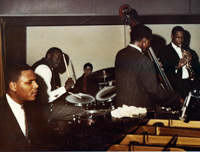 We close this investigation with “Wise One.” It's John Coltrane (tenor sax), McCoy Tyner (piano), Jimmy Garrison (bass) and Elvin Jones (drums) recorded at the Rudy Van Gelder Studio, Englewood Cliffs, New Jersey, April 27, 1964. Trane recorded “Wise One” in the spring; by winter of the same year, on December 9, 1964, Coltrane would cut his masterwork, A Love Supreme. I think it is important to contextualize the chronology of Coltrane’s work so we can fully appreciate how incredibly productive, prolific and profound John Coltrane was as a recording artist.
I’ve written about this one before but “Wise One” bears further examination. Here we have the classic quartet from a classic album, Crescent.
We close this investigation with “Wise One.” It's John Coltrane (tenor sax), McCoy Tyner (piano), Jimmy Garrison (bass) and Elvin Jones (drums) recorded at the Rudy Van Gelder Studio, Englewood Cliffs, New Jersey, April 27, 1964. Trane recorded “Wise One” in the spring; by winter of the same year, on December 9, 1964, Coltrane would cut his masterwork, A Love Supreme. I think it is important to contextualize the chronology of Coltrane’s work so we can fully appreciate how incredibly productive, prolific and profound John Coltrane was as a recording artist.
I’ve written about this one before but “Wise One” bears further examination. Here we have the classic quartet from a classic album, Crescent.
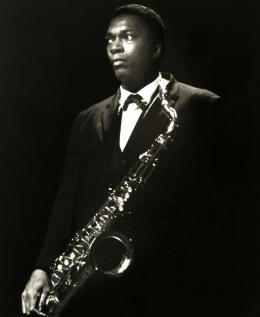 This is deep Coltrane solemnly meditating. Trane’s solo is sublime, a transcendent example of the use of simple, unhurried playing, letting the tone of his sound carry the gravity. Again, notice how the song (and it actually feels like a song even though there are no lyrics) is set up with both a walking blues feel and a Latin rhythm. Rhythm-wise it’s amazingly complex even as the melody is straight forward.
What Coltrane got to was the complexity of the blues, the swirl of emotions at the center of one’s being. The contradictions of one’s life: at any given moment of peace, one is grappling with all kinds of contending forces. Coltrane gives voice to the stillness at the center of the storm: i.e. the blues.
These are not the only examples. There are many more but this is enough wine to be drunk at one time, especially for those used to soft drinks!
—Kalamu ya Salaam
Trane at his most accessible
If I remember correctly, Blue Train was the second John Coltrane CD I ever bought. I was into it right away. Despite the very long solo (I'm talking about the title track specifically), this is Trane at his most accessible. The easy swing, clear tones and straight-ahead nature of the playing all make it listenable for the average non-jazz afficionado. I hope people who can't quite get into stuff like "Impressions" or even "Love Supreme" do find "Blue Train" easier to listen to.
The thing is, you have to start somewhere and once you start, Trane tends to pull you in. Before you know it, things that previously sounded too wild or free or crazy start to make sense. Get into "Mr. Syms" and before you know it, you'll be swinging to "Equinox." Figure out "Like Sonny" and some of Elvin John's more polyrhythmic efforts, "Tunji" maybe, will be a lot easier to deal with. It's worth it too. There's a reason Kalamu writes so much about Coltrane — when it comes to jazz, Trane is simply superlative.
—Mtume ya Salaam
This is deep Coltrane solemnly meditating. Trane’s solo is sublime, a transcendent example of the use of simple, unhurried playing, letting the tone of his sound carry the gravity. Again, notice how the song (and it actually feels like a song even though there are no lyrics) is set up with both a walking blues feel and a Latin rhythm. Rhythm-wise it’s amazingly complex even as the melody is straight forward.
What Coltrane got to was the complexity of the blues, the swirl of emotions at the center of one’s being. The contradictions of one’s life: at any given moment of peace, one is grappling with all kinds of contending forces. Coltrane gives voice to the stillness at the center of the storm: i.e. the blues.
These are not the only examples. There are many more but this is enough wine to be drunk at one time, especially for those used to soft drinks!
—Kalamu ya Salaam
Trane at his most accessible
If I remember correctly, Blue Train was the second John Coltrane CD I ever bought. I was into it right away. Despite the very long solo (I'm talking about the title track specifically), this is Trane at his most accessible. The easy swing, clear tones and straight-ahead nature of the playing all make it listenable for the average non-jazz afficionado. I hope people who can't quite get into stuff like "Impressions" or even "Love Supreme" do find "Blue Train" easier to listen to.
The thing is, you have to start somewhere and once you start, Trane tends to pull you in. Before you know it, things that previously sounded too wild or free or crazy start to make sense. Get into "Mr. Syms" and before you know it, you'll be swinging to "Equinox." Figure out "Like Sonny" and some of Elvin John's more polyrhythmic efforts, "Tunji" maybe, will be a lot easier to deal with. It's worth it too. There's a reason Kalamu writes so much about Coltrane — when it comes to jazz, Trane is simply superlative.
—Mtume ya Salaam
This entry was posted on Monday, July 14th, 2008 at 12:00 am and is filed under Classic. You can follow any responses to this entry through the RSS 2.0 feed. You can leave a response, or trackback from your own site.
2 Responses to “JOHN COLTRANE / “Blue Train””
July 17th, 2008 at 3:06 pm
Very beautiful music. It always surprises me how many jazz songs I “know” in the back of my mind. Thanks to your humongous collection, Baba.
February 17th, 2009 at 7:13 pm
Thanks for this post about “Blue Train.” I agree that this Blue Note album is an ideal introduction for listeners who are not quite ready for the later “sheets of sound” period. Trombone player Curtis Fuller was one of the unsung heroes of Blue Note records, so his presence on “Blue Train” is definitely appreciated. I am beginning to think Philly Joe Jones is my favorite drummer, too.
Leave a Reply
| top |